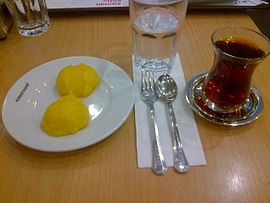| Revision as of 20:31, 26 September 2015 edit95.70.238.64 (talk) →Etymology← Previous edit | Latest revision as of 13:51, 29 August 2024 edit undoTiopyas (talk | contribs)7 editsmNo edit summaryTags: Visual edit Mobile edit Mobile web edit | ||
| (29 intermediate revisions by 24 users not shown) | |||
| Line 1: | Line 1: | ||
| {{short description|Flour-based cheese helvah}} | |||
| {{Infobox |
{{Infobox food | ||
| | name = Hoşmerim | |||
| | |
| name = Höşmerim | ||
| | |
| image = Peynir helva.jpg | ||
| | image_size = 270px | |||
| | caption = Hoşmerim and Turkish tea | |||
| | alternate_name = | | alternate_name = | ||
| | country = |
| country = Turkey | ||
| | region = | | region = | ||
| | creator = | | creator = | ||
| Line 10: | Line 12: | ||
| | type = | | type = | ||
| | served = | | served = | ||
| | main_ingredient = | | main_ingredient = ], ], ], ], ] | ||
| | variations = | | variations = | ||
| | calories = | | calories = | ||
| | other = | | other = | ||
| }} | }} | ||
| ''' |
'''Höşmerim''' or '''hoşmerim''' is a ] popular in the ], ], ] and ], ], ] regions of Turkey. It is sometimes called ''peynir helva'' or "cheese ]". It is generally consumed after a meal as a light ] and may be topped with ], ] or ]. | ||
| Höşmerim has been served for 50–55 years as a commercial product in the markets and ] shops. However, most of its manufacture occurs on a small scale. Recipes and methods may differ from one region to another. Traditional recipes include fresh unsalted ], ] and powdered ]. Commercially produced ''höşmerim'' may include ], ] and ] in addition to the traditional ingredients for the homemade varieties. | |||
| ==Etymology== | ==Etymology== | ||
| The Turkish word ''hoşmerim'' is loaned from the ] word ''χʷoş-maram'' (خوش مرم). It is a compound word, derived from ''χʷoş'' (خوش), meaning "sweet" and ''maram'' (مرم), meaning "]". The oldest attested use of the word in a Turkic language is found in ]'s 1540 dictionary ''].''<ref>{{cite web | url=http://nisanyansozluk.com/?k=hoşmerim | title=Nişanyan Sözlük - Türkçe Etimolojik Sözlük }}</ref> | |||
| ⚫ | According to the ], a soldier could not see his wife for a long time because of the war. When the war finished, man came to his village and saw his wife. His wife prepared Hoşmerim and asked her husband "Hoş mu erim?" meaning "Is it nice, my man?" | ||
| ⚫ | According to the ], a soldier could not see his wife for a long time because of the war. When the war finished, man came to his village and saw his wife. His wife prepared Hoşmerim and asked her husband "Hoş mu erim?" meaning "Is it nice, my man?"{{Citation needed|date=October 2020}} | ||
| In reality, it comes from Persian ''xoş'' (sweet) + ''maram'' (]).<ref>http://nisanyansozluk.com/?k=hoşmerim</ref> | |||
| ==See also== | ==See also== | ||
| Line 26: | Line 30: | ||
| *] | *] | ||
| *] | *] | ||
| *] | |||
| == References == | == References == | ||
| Line 34: | Line 37: | ||
| {{DEFAULTSORT:Hosmerim}} | {{DEFAULTSORT:Hosmerim}} | ||
| ] | ] | ||
| ] | ] | ||
| ] | |||
| ] | ] | ||
| ] | |||
| ] | ] | ||
| {{ |
{{Turkey-cuisine-stub}} | ||
| {{Azerbaijan-cuisine-stub}} | |||
Latest revision as of 13:51, 29 August 2024
Flour-based cheese helvah Hoşmerim and Turkish tea Hoşmerim and Turkish tea | |
| Course | Dessert |
|---|---|
| Place of origin | Turkey |
| Main ingredients | Semolina, cheese, sugar, milk, almond |
Höşmerim or hoşmerim is a Turkish dessert popular in the Aegean, Marmara, Trakya and Central Anatolia, Black Sea, East Black Sea regions of Turkey. It is sometimes called peynir helva or "cheese halva". It is generally consumed after a meal as a light dessert and may be topped with ice cream, honey or nuts.
Höşmerim has been served for 50–55 years as a commercial product in the markets and pastry shops. However, most of its manufacture occurs on a small scale. Recipes and methods may differ from one region to another. Traditional recipes include fresh unsalted cheese, semolina and powdered sugar. Commercially produced höşmerim may include cream, egg and riboflavin in addition to the traditional ingredients for the homemade varieties.
Etymology
The Turkish word hoşmerim is loaned from the Persian word χʷoş-maram (خوش مرم). It is a compound word, derived from χʷoş (خوش), meaning "sweet" and maram (مرم), meaning "kaymak". The oldest attested use of the word in a Turkic language is found in Ni‘mettullāh bin Aḥmed bin Ḳāżī Mübārek er-Rūmī's 1540 dictionary Lügat-i Ni'metu'llâh.
According to the folk etymology, a soldier could not see his wife for a long time because of the war. When the war finished, man came to his village and saw his wife. His wife prepared Hoşmerim and asked her husband "Hoş mu erim?" meaning "Is it nice, my man?"
See also
References
This Turkish cuisine-related article is a stub. You can help Misplaced Pages by expanding it. |
This Azerbaijani cuisine-related article is a stub. You can help Misplaced Pages by expanding it. |